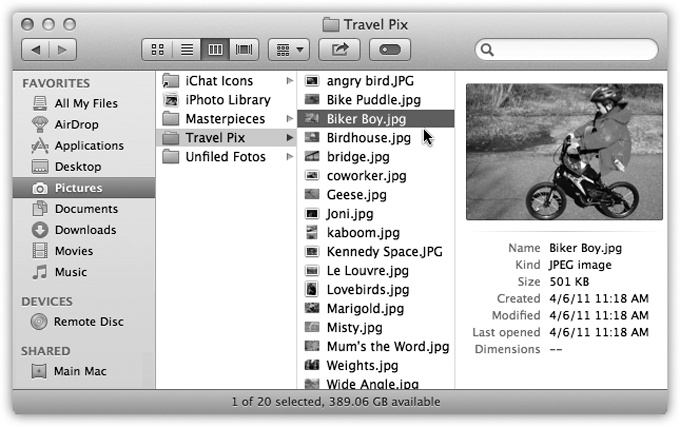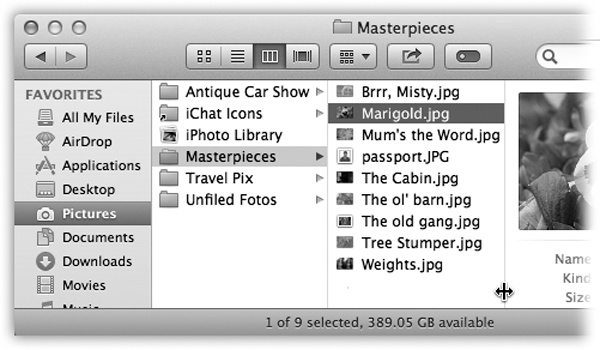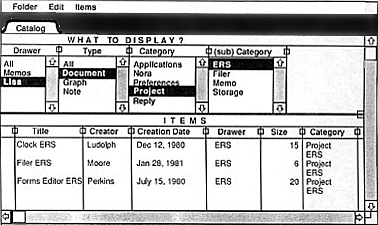The goal of column view is simple: to let you burrow down through nested folders without leaving a trail of messy, overlapping windows in your wake.
The solution is shown in Figure 1-21. It’s a list view that’s divided into several vertical panes. The first pane (not counting the Sidebar) shows whatever disk or folder you first opened.
Figure 1-21. If the rightmost folder contains pictures, sounds, Office documents, or movies, you can look at them or play them, right there in the Finder. You can drag this jumbo preview icon anywhere—into another folder or to the Trash, for example.
When you click a disk or folder in this list (once), the second pane shows a list of everything in it. Each time you click a folder in one pane, the pane to its right shows what’s inside. The other panes slide to the left, sometimes out of view. (Use the horizontal scroll bar to bring them back.) You can keep clicking until you’re looking at the file icons inside the most deeply nested folder.
If you discover that your hunt for a particular file has taken you down a blind alley, it’s not a big deal to backtrack, since the trail of folders you’ve followed to get here is still sitting before you on the screen. As soon as you click a different folder in one of the earlier panes, the panes to its right suddenly change, so that you can burrow down a different rabbit hole.
The beauty of column view is that, first of all, it keeps your screen tidy. It effectively shows you several simultaneous folder levels but contains them within a single window. With a quick ⌘-W, you can close the entire window, panes and all. Second, column view provides an excellent sense of where you are. Because your trail is visible at all times, it’s much harder to get lost—wondering what folder you’re in and how you got there—than in any other window view.
Efficiency fans can operate this entire process by keyboard alone. For example:
You can jump from one column to the next by pressing the
 or
or  keys. Each press highlights the first
icon in the next or previous column.
keys. Each press highlights the first
icon in the next or previous column.You can use any of the commands in the Go menu, or their keyboard equivalents, or the icons in the Sidebar, to fill your columns with the contents of the corresponding folder—Home, Favorites, Applications, and so on.
The Back command (clicking the
 button on the toolbar, pressing ⌘-[, or choosing
Go→Back) works as it does in a Web browser: It retraces your
steps backward. You can repeat this command until you return to
the column setup that first appeared when you switched to column
view. Once you’ve gone back, in fact, you can then go forward
again; choose Go→Forward, or press ⌘-].
button on the toolbar, pressing ⌘-[, or choosing
Go→Back) works as it does in a Web browser: It retraces your
steps backward. You can repeat this command until you return to
the column setup that first appeared when you switched to column
view. Once you’ve gone back, in fact, you can then go forward
again; choose Go→Forward, or press ⌘-].Within a highlighted column, press the
 or
or  keys to highlight successive icons in the
list. Or type the first couple of letters of an icon’s name to
jump directly to it.
keys to highlight successive icons in the
list. Or type the first couple of letters of an icon’s name to
jump directly to it.When you finally highlight the icon you’ve been looking for, press ⌘-O or ⌘-
 to open it (or double-click it, of
course). You can open anything in any column; you don’t have to
wait until you’ve reached the rightmost column.
to open it (or double-click it, of
course). You can open anything in any column; you don’t have to
wait until you’ve reached the rightmost column.
The number of columns you can see without scrolling depends on the width of the window. That’s not to say, however, that you’re limited to four columns (or whatever fits on your monitor). You can make the columns wider or narrower—either individually or all at once—to suit the situation, according to this scheme:
To make a single column wider or narrower, drag the fine vertical line that separates it from the column to its right (see Figure 1-22).
To make all the columns wider or narrower simultaneously, hold down the Option key as you drag one of the divider lines.
To make a column precisely as wide as necessary to reveal all the names of its contents, double-click the divider line on its right side.
To make all columns as wide as required—when you absolutely, positively don’t want any names truncated—Option-double-click a column’s right-side divider line.
Tip
If you’re having trouble remembering all of those key and click combinations, you’re not alone. Fortunately, you can use a new right-click trick instead.
If you right-click or two-finger click the divider line at the right side of a column, you get a shortcut menu that offers these commands: Right Size This Column (make it exactly as wide as necessary), Right Size All Columns Individually (make every column exactly as wide as necessary), and Right Size All Columns Equally (make all columns the same width, based on whatever width is necessary to see all the names in the narrowest one).
Yes, the Arrange commands are available to column view, too; you can add those gray category headings to the clumps of files in each window. And, once again, you can also use the Sort By commands to change the sequence of files within each grouping. It all works exactly as described starting on Use as Defaults.
Just as in icon and list view, you can choose View→Show View Options to open a dialog box—a Spartan one, in this case—offering additional control over your column views.
Always open in column view. Once again, this option lets you override your system-wide preference setting for all windows. See Always open in icon view for details.
Browse in column view. Ensures that any folder inside this one will open up in column view when double-clicked.
Arrange By, Sort By. You can put column-view icons into arranged groups—and sort them within those groups—just as described starting on Use as Defaults.
Text size. Whatever point size you choose here affects the type used for icons in all column views.
Show icons. For maximum speed, turn off this option. Now you see only file names—not the tiny icons next to them—in all column views. Weird!
Show icon preview. Turn off this option if you don’t want the tiny icons in column view to display their actual contents—photos showing their images, Word and PDF documents showing their first pages, and so on. You get generic, identical icons for each file type (text, photo, or whatever).
Show preview column. The far-right Preview column can be handy when you’re browsing graphics, sounds, or movie files. Feel free to enlarge this final column when you want a better view of the picture or movie; you can make it really big.
The rest of the time, though, the Preview column can get in the way, slightly slowing down the works and pushing other, more useful columns off to the left side of the window. If you turn off this checkbox, the Preview column doesn’t appear.
Tip
No matter what view you’re in, remember this: If you ever start dragging an icon and then change your mind, just press the Esc key or ⌘-period, even while the mouse button is still down. The icon flies back to its precise starting place. Or, if you’ve already dragged something to a new window and now you regret it, press ⌘-Z (for Undo). Too bad real life doesn’t have a similar feature.
Get OS X Mavericks: The Missing Manual now with the O’Reilly learning platform.
O’Reilly members experience books, live events, courses curated by job role, and more from O’Reilly and nearly 200 top publishers.




